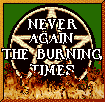|
|
|
|
History  Witch is an Anglo-Saxon word meaning 'to bend' or 'to shape'. A definition of Witch, therefore, might be: 'one who bends or shapes consciousness or events." Four hundred years ago women healers were burnt at the stake for witchcraft even though most of them relied on Christian faith to assist in their healings. The Roman Catholic Church set up the Inquisition to enforce its will upon the population; especially targeting anyone who criticized the church, or who held a different belief system. These people were charged with Heresy and executed as enemies of the State and Church. High estimates are that 9 million were executed in 300 years. Think about that! In a little under 300 years, a way of life that had endured for thousands of years was almost completely destroyed. 85% of those executed were women, which is why the Burning Times are sometimes referred to as The Women's Holocaust. The Old Ways, pagan ways, were agrarian, based on moon phases, crop cycles, tides, and seasonal changes. These ways honored the Earth as sacred and the traditions were passed down within families and apprentices for decades. Pagans honored life experiences, events in daily life like the birthing of animals, planting and harvesting crops, and were based on custom and tradition. The Wise Women, or local healers, and most WERE female, knew the principles of anatomy and nutrition. They birthed babies and held the dying in their arms. They knew how ease the pains of labor and induce miscarriage to save a life. Pagan ways were the ways of the ordinary people, the simple folk. In 1431 the Church burned Joan of Arc at the stake as a witch despite the fact that it was through the help of her presence, guidance, and visionary experiences that had led them to win a war that had lasted for 100 years. They burned her because she maintained that her 'voices' gave her an authority greater than that of the Church. Because it was unacceptable to the Church leaders and considered to be a direct challenge to their authority, they prosecuted her for heresy and burned her, alive, at the stake. I doubt the fact that they later made her a Saint helped. This case, however, reveals a great deal about the Burning Times. The Church was rigid and dogmatic about their own authority. If, as Joan claimed, anyone could receive divine revelation, or guidance from the Source, then the Church was wrong. Rather than admit such a thing the Church moved to quash anyone who opposed their authority. Several of the Inquisitors are on record as saying that no-one did more harm to the Church authority than mid-wives, the local healers. Soon they passed laws stating that anyone caught healing others without having studied at a University was a witch and must die. It is interesting to note that women were not allowed to attend the Universities. The Witch hunts became a major business by providing many jobs and guaranteeing that the male, medical profession would rise. Land owners, feudal lords, and disgruntled friends, or enemies, could point a finger and machine the of the Inquisition would take over, much like the machine of the Gestapo took over in Nazi Germany. The friendly, Matriarchy began to fall as the Patriarchy came to power. Any signs of peasant revolt or individual thought, were met with accusations of being the enemy of God. Charges of witchcraft soon followed. Thomas Aquinas said the Greatest pleasure next to beholding the Lamb of God would be to watch the torture of the eternally damned. How enlightened! He, like many other religious leaders of the time saw women as being the cause of the Fall and an obstacle to man's holiness. Remember that ideas are reinforced by art and literature. And who supported the Arts and literature besides men in power and the Church. Better to go along with the reprehensible ideas than take the chance of having a finger pointed at you...rather than your neighbor. The Renaissance, the age of science, completely relied on the techniques set down the Inquisition. Sir Francis Bacon said it was important to use the techniques of the Inquisition to tease and torture the secrets of Mother nature out into the open. What of the business of the witch hunts? The Renaissance brought with it the rise of capitalism and a new profit ethic, as Starhawk calls it. Witch hunts were good business because they opened up many jobs. There were records to be kept, each aspect of the arrest, torture, imprisonment, trial, guarding, food, and execution cost money. Not to mention the lawyers, judges, witnesses, and tribunal costs. Upon arrest the prisoner's assets and property were seized. There was even a book, commissioned by Pope Innocent VIII, that was used to question the witches. The Witch's Hammer, which was one of the first books to achieve mass printing. The book specifically targeted women as the primary source of witchcraft. "No monuments have been built to their memory. Only a few relics, like the Witch's Cart, remain to mark their passing. Six generations of children watched their mother's burned at the stake. History is written by the winners." Starhawk And this is why, on October 31, thousands of women, and men, gather and remember those who died.
© © 2000 CDM Services |